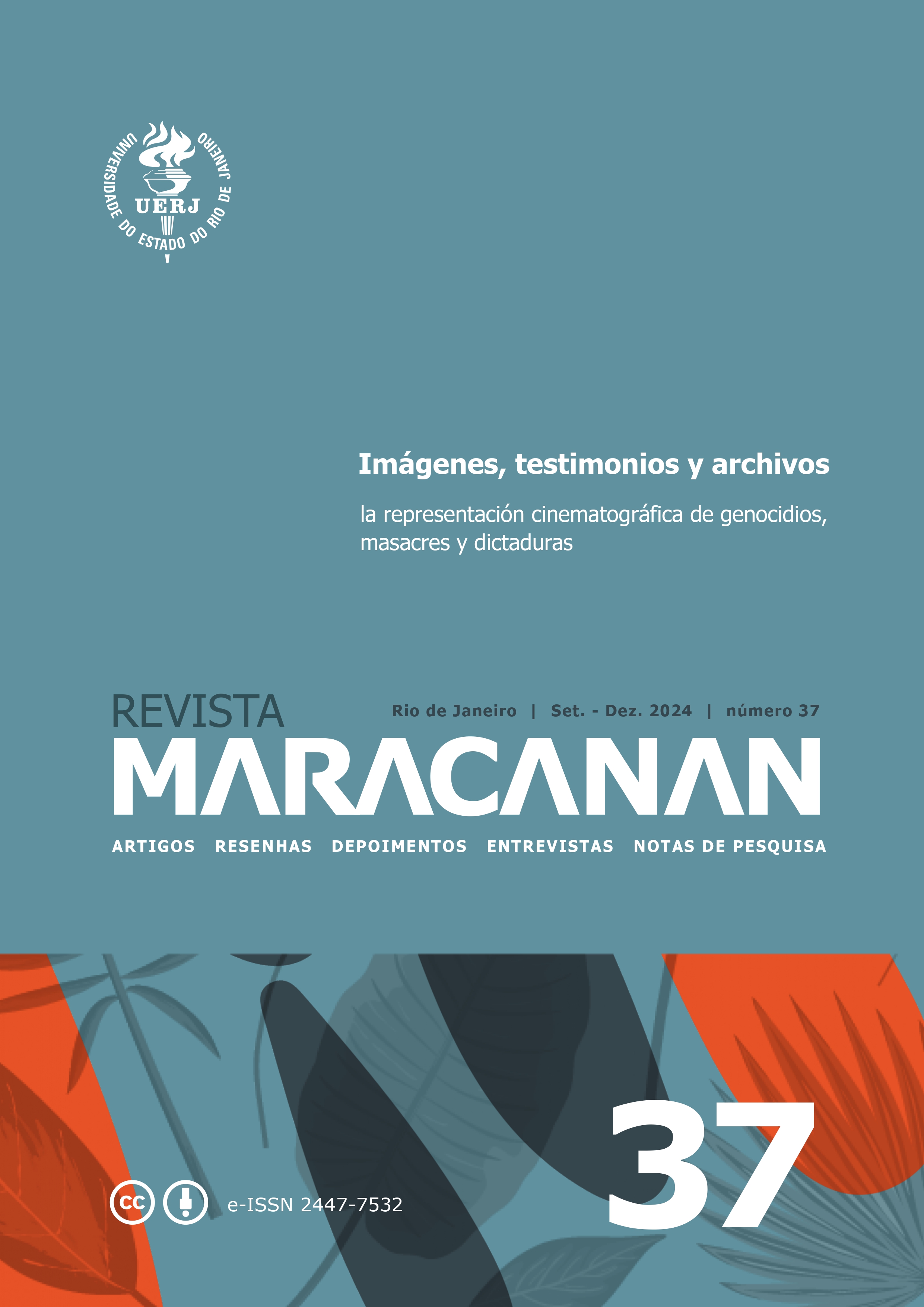Educação visual sobre o Holocausto:
sensibilização e ética na utilização de imagens históricas
DOI:
https://doi.org/10.12957/revmar.2024.84763Palavras-chave:
Educação, Imagens, Inteligência Artificial, HolocaustoResumo
Durante muito tempo, a pesquisa em educação sobre o Holocausto se concentrou na transmissão de fatos históricos e na preservação da memória coletiva. Contudo, há uma lacuna significativa no que tange ao uso ético e contextualizado de imagens, especialmente aquelas geradas por inteligência artificial, no ensino desse tema sensível. Para explorar esse tema, o presente artigo analisa a importância da contextualização e do uso ético de imagens no ensino do Holocausto, enfatizando a responsabilidade dos educadores em selecionar materiais visuais que respeitem a dignidade das vítimas e promovam uma compreensão crítica dos eventos históricos. Baseado nas diretrizes da Associação Brasileira de Ensino de História e nos princípios da International Holocaust Remembrance Alliance, o estudo realiza uma análise qualitativa de práticas pedagógicas de artigos científicos com foco na integração de imagens no currículo e na identificação de lacunas na Base Nacional Comum Curricular relacionadas ao Holocausto. Os resultados indicaram que, embora a tecnologia possa enriquecer o ensino, a falta de contextualização e reflexão crítica no uso de imagens pode comprometer a integridade do processo educacional. Como principal contribuição, o artigo destaca a necessidade de uma abordagem ética e cuidadosa no uso de imagens no ensino do Holocausto e sugere a inclusão de referências explícitas ao tema na BNCC, visando fortalecer a formação crítica e empática dos estudantes.
Referências
ADORNO, Theodor. Educação após Auschwitz. São Paulo: Ática, 1986.
ABEH. Associação Brasileira de Ensino De História. Compromissos éticos da docência em história. [S. l.]: [s. n.], 2022. Disponível em: https://www.abeh.org.br/download/download?ID_DOWNLOAD=14. Accesso en: 20 ago. 2024.
BOYER, Eric S. Exploring Difficulties in Teaching Holocaust Education, and an Explanation of Classroom Practices to Overcome These Difficulties. Russian American Education Forum: An Online Journal, v. 4, n. 3, 2012. Disponível em: http://www.rus-ameeduforum.com/content/en/?task=art&article=1000943&iid=13. Accesso en: 30 maio 2024.
BRASIL. Ministério da Educação. Base Nacional Comum Curricular. 2017. Disponível em: http://basenacionalcomum.mec.gov.br/. Accesso en: 20 ago. 2024.
BULGER, Monica; DAVISON, Patrick. The Promises, Challenges, and Futures of Media Literacy. Analysis & Policy Observatory. Data & Society Research Institute, 2018.
BURKE, Peter; XAVIER, Maria. Testemunha Ocular: História e Imagem. Bauru, SP: Edusc, 2004.
COWAN, Paula; MAITLES, Henry. Does Addressing Prejudice and Discrimination through Holocaust Education Produce Better Citizens? Educacional Review, v. 59, n. 2, p. 115-130, 2007. DOI: https://doi.org/10.1080/00131910701254858.
CRANE, Susan A. Choosing Not to Look: Representation, Repatriation, and Holocaust Atrocity Photography. History and Theory, v. 47, n. 3, p. 309-330, 2007. DOI: https://doi.org/10.1111/j.1468-2303.2008.00457.x.
DIDI-HUBERMAN, Georges. Imagens Apesar de Tudo. Lisboa: KKYM, 2012.
EVANS, Jennifer V.; FAGEN, Erica; LUNDRIGAN, Meghan. Holocaust Memory in the Digital Mediascape. London: Bloomsbury Academic, 2023.
GAMBER, Cayo. AI Technology, Holocaust Survivors, and Human Interactions at Holocaust Museums. AHFE International, 2023. DOI: https://doi.org/10.54941/ahfe1004005.
HARIMAN, Robert; LUCAITES, John Louis. No Caption Needed: Iconic Photographs, Public Culture, and Liberal Democracy. Chicago: University of Chicago Press, 2007.
HUESMANN, L. Rowell; KIRWIL, Lucyna. Why Observing Violence Increases the Risk of Violent Behavior by the Observer. In: FLANNERY, Daniel J.; VAZSONYI, Alexander T.; WALDMAN, Irwin D. (Orgs.). The Cambridge Handbook of Violent Behavior and Aggression. Cambridge: Cambridge University Press, 2007. DOI: https://doi.org/10.1017/cbo9780511816840.029.
IHRA. International Holocaust Remembrance Alliance. Recomendações para o Ensino e a Aprendizagem sobre o Holocausto. 2019. Disponível em: https://www.holocaustremembrance.com/sites/default/files/inline-files/Recomendac%CC%A7o%CC%83es%20para%20o%20Ensino%20e%20a%20Aprendizagem%20sobre%20o%20Holocausto.pdf. Accesso en: 30 maio 2024.
KOVAČ, Danilo. A Case Study Comparing Good Practice in the Use of Pedagogical Resources in Holocaust Education in England and Republika Srpska. Istorija 20. Veka, v. 40, n. 1/2022, p. 233-251, 2022. DOI: https://doi.org/10.29362/ist20veka.2022.1.kov.233-251.
LANDAU, R. The Nazi Holocaust. Choice Reviews Online, v. 32, n. 1, p. 32-046932-0469, 1992. DOI: https://doi.org/10.5860/choice.32-0469.
LEE, Peter; ASHBY, Rosalyn. Knowing, Teaching, and Learning History: National and International Perspectives. In: STEARNS, Peter N.; SEIXAS, Peter; WINEBURG, Sam (Orgs.). Knowing, Teaching, and Learning History: National and International Perspectives. New York: New York University Press, 2000.
LU, Zeyu; et al. Seeing Is Not Always Believing: A Quantitative Study on Human Perception of AI-Generated Images. ArXiv.org, 25 abr. 2023. DOI: https://doi.org/10.48550/arXiv.2304.13023.
MILTON, S. Visualizing the Holocaust: A Curricular Response to Holocaust Representation. Journal of Genocide Research, v. 16, n. 3, p. 363-387, 2014.
MIRZOEFF, Nicholas. An Introduction to Visual Culture. New York: Routledge, 1999.
ROSENZWEIG, Roy; THELEN, David. The Presence of the Past: Popular Uses of History in American Life. New York: Columbia University Press, 2000.
SANCHEZ, Barbara C. Internet Memes and Desensitization. Pathways: A Journal of Humanistic and Social Inquiry, v. 1, n. 1, 2020.
SCHWARTZ, Joan M.; COOK, Terry. Archives, Records, and Power: The Making of Modern Memory. Archival Science, v. 2, n. 1-2, p. 1-19, 2002. DOI: https://doi.org/10.1007/bf02435628.
SCHWEBER, Simone. Holocaust Fatigue. Teaching Today. Social Education, v. 70, n. 1, p. 44, 2006.
UMBACH, Maiken; MILLS, Gary. Teaching with Images: Opportunities and Pitfalls for Holocaust Education. Holocaust Studies, p. 1-19, set. 2023. DOI: https://doi.org/10.1080/17504902.2023.2249296.
WITTKOWER, Dylan. On the Origins of the Cute as a Dominant Aesthetic Category in Digital Culture. In: SPRINGER, Berlin. Putting Knowledge to Work and Letting Information Play. Boston: Springer, 2023.
ZELIZER, Barbie. Remembering to Forget: Holocaust Memory through the Camera’s Eye. Chicago: University of Chicago Press, 2000.
Downloads
Publicado
Como Citar
Edição
Seção
Licença
Copyright (c) 2024 Luciana Sanguiné, Débora Karpowicz

Este trabalho está licenciado sob uma licença Creative Commons Attribution 4.0 International License.
Os autores mantêm os direitos autorais e concedem à Revista Maracanan o direito de publicação, sob uma Licença Creative Commons Atribuição 4.0 Internacional, a qual permite que outros distribuam, remixem, adaptem e criem a partir do seu trabalho, mesmo para fins comerciais, desde que lhe atribuam o devido crédito pela criação original.
Os dados e conceitos abordados são da exclusiva responsabilidade do autor.
A Revista Maracanan está licenciada com uma Licença Creative Commons Atribuição 4.0 Internacional.





